2012 VOLKSWAGEN GOLF MK6 manual transmission
[x] Cancel search: manual transmissionPage 252 of 516

Volkswagen Service Vehicles with Xenon
gas-discharge self-adjust to vehicle load
and do not need manual adjustment.
Special towing considerations
th e t railer has an overrun brake, apply the
br akes
Due to the combined towing weight including
the higher gross vehicle weight, the stopping
tance is longer.
Be fo re drivi ng especially on
The vehicle's center of grav ity and , in turn, the
Weight distribution is especially bad if the is emp ty and the trailer is loaded.
Depending on how steep the is an d the
backwards when you first start moving.
When starting off with a tra iler on a
Depress and hold the brake pedal and depress
and hold the clutch (manu al transmission).
171, Shifting .
Unlock the parking brake a nd gently release it
whi le holding the unlock button. At the same time,
release the brake pedal and
depress the
accelerator and, for manual transmissions , let out
the clutch
you can feel the car moving ward . applicable, follow the instruct ions for the Hold feat ure
Do not release the parking brake lever until the
engine starts to move the vehicle forward. your
vehicle has an automatic tr ansmission , you can
so depress and hold the brake peda l for added
b raking and then Jet up on the brake pedal when
you feel that the to move forward .
Drive ahead slowly.
hicle contro l and serious per sonal injury.
dles and increases the distance it needs to stop safely .
Always adapt your sp ee d and driving to th e heavier loa d and the weight distribution in the vehicle. Tak e road , weather , traffic, and visibility conditions into account as well .
Always avoid sudde n maneuv ers and ha rd braking.
atin g.
som e areas
s p ee d for vehicles towing trailers are
lower than for vehicles without trailers.
Page 265 of 516
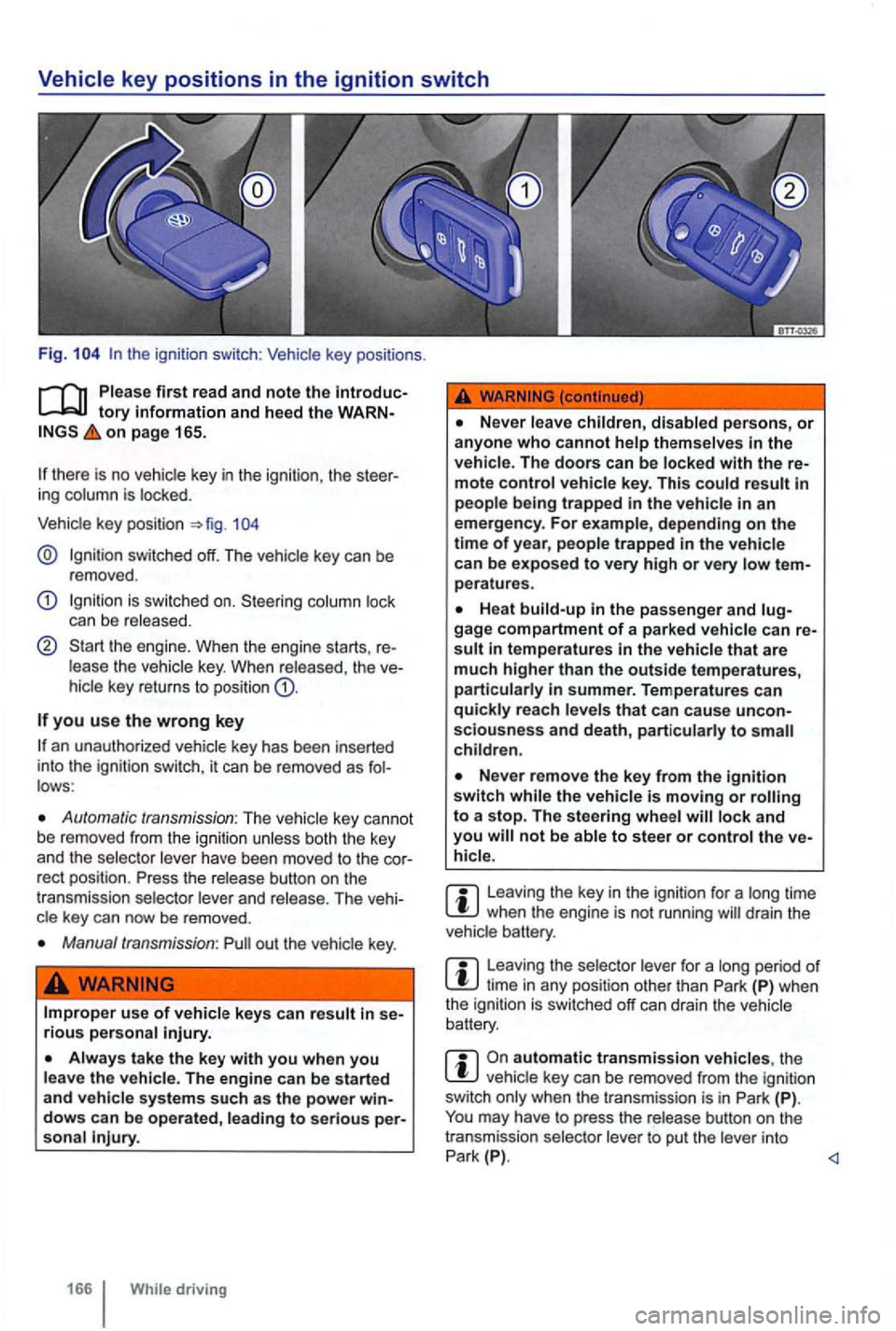
Fig.
tory information and heed the on page 165.
there is no key in the ignition, the
key posi tio n
key can be
r emoved .
Ignit ion is switched on . S teering
the engi ne. When the e ngin e starts . key. When the key return s to position
you use the wrong key
an unautho rized key has bee n in serted
int o the ignition switch , it can be removed as
Automatic transmission : The vehicle key cannot
b e remo ved from the
rect position . Press the and The key can now be removed .
Manual transmission : out the
rious
tak e the key with you when you the The engine can be s tart ed
and s ystems such as the power to seriou s injury.
..
Never disabled persons, or anyone who cannot themselves in the The doors can be locked with the
in an emergency . For example, dependi ng on the time of year, people trapped in the can be exposed to very high or very
gage compartment of a parked that are
much higher than the outside temperatures, in summer. Temperature s can reach sciousness and d eath , to
Never remove the key from the ignition switch the
to stee r or control the
Leaving the key in the igni tion for a when th e engine is no t running drai n the
vehic le battery .
Leaving the selec tor for a period of time in any positi on other than Park (P) whe n
the ignition is swi tched off can drain the ve hi cle
bat tery.
automati c tran smi ssion vehic les, the key can be removed from the ignition
sw itch
may have to press the release button on the
t ransmission selector to put th e into Park (P) .
Page 270 of 516
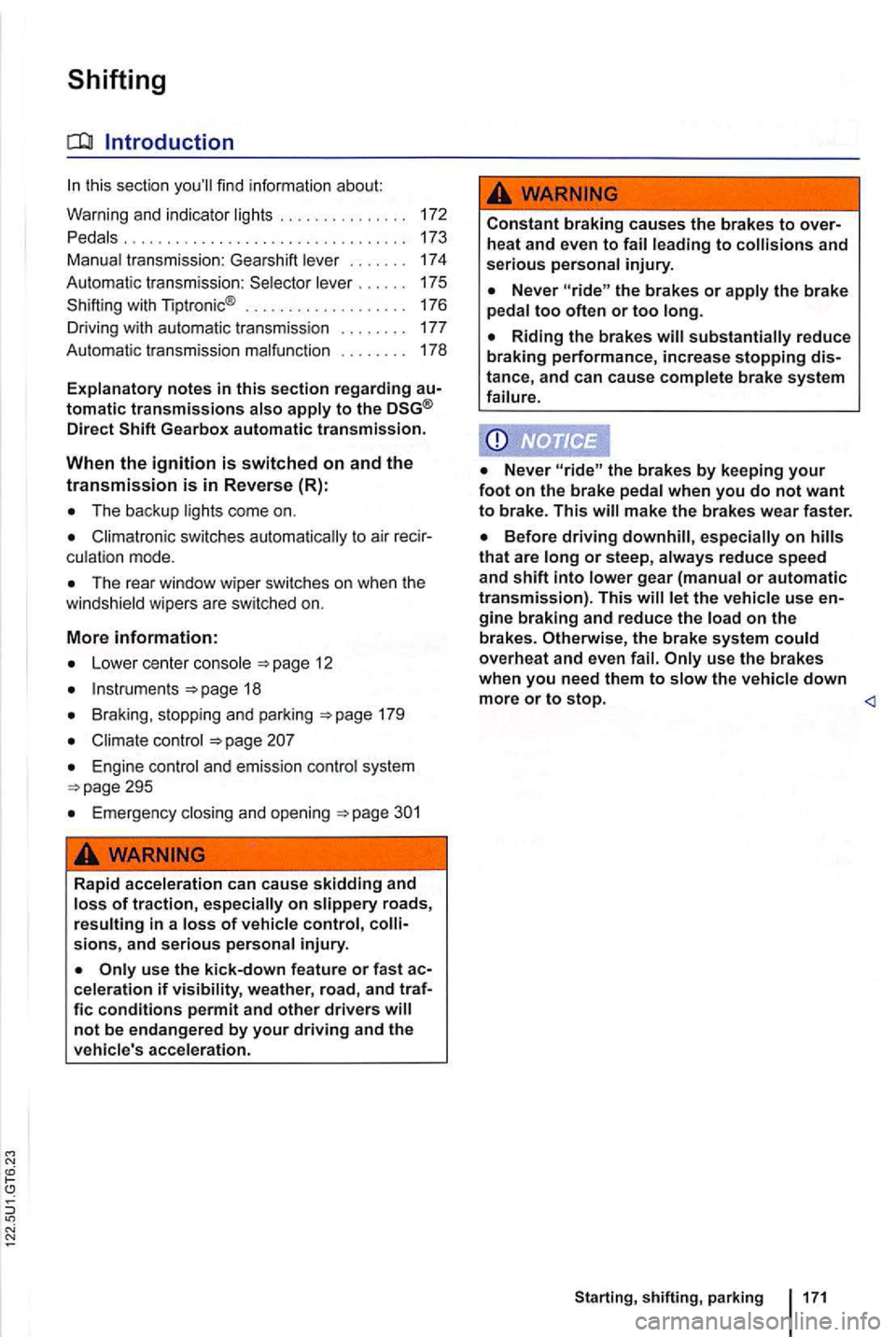
Shifting
Introduction
this section find information about:
Warning
and i ndicator ... .. . .
Pedals
............. ........... .
Manual transmission: Gearshift lever
172
173
174
Automat ic transm ission :
lever.... 175
Sh ifting with nptro nic ® . . . . . . . . . . . . . . . . . . 176
Driving with automatic transmiss ion 177
Automat ic transmission malfunction . . . . . . . . 178
Explanatory
notes in this sec tion regarding
Direct
The backup lights come on.
Climatronic switches to air culation mode.
The rear window wiper switches on when the
windshield wipers are switched on.
More information:
Braking , stoppi ng and parking 179
Climate control
Engine control and emission control system
Emergency
Rapid acceleration can cause skidding and loss of traction , especially on slippery roads,
re sulting in a loss of vehicle control, sions, and seriou s personal injury.
use the kick-down feature or fast cele ration if visibility, weather, road, and
Constant braking causes the brakes to and se rious personal injury.
the brakes or apply the brake
pedal too often or too long.
substantially reduce braking performance, increase stopping
the brakes by keeping your foot on the brake pedal when you do not want to brake . Thi s make the brakes wear faster.
gine braking and reduce the load on the brakes. Otherwise , the brake system could overheat and even
Page 273 of 516
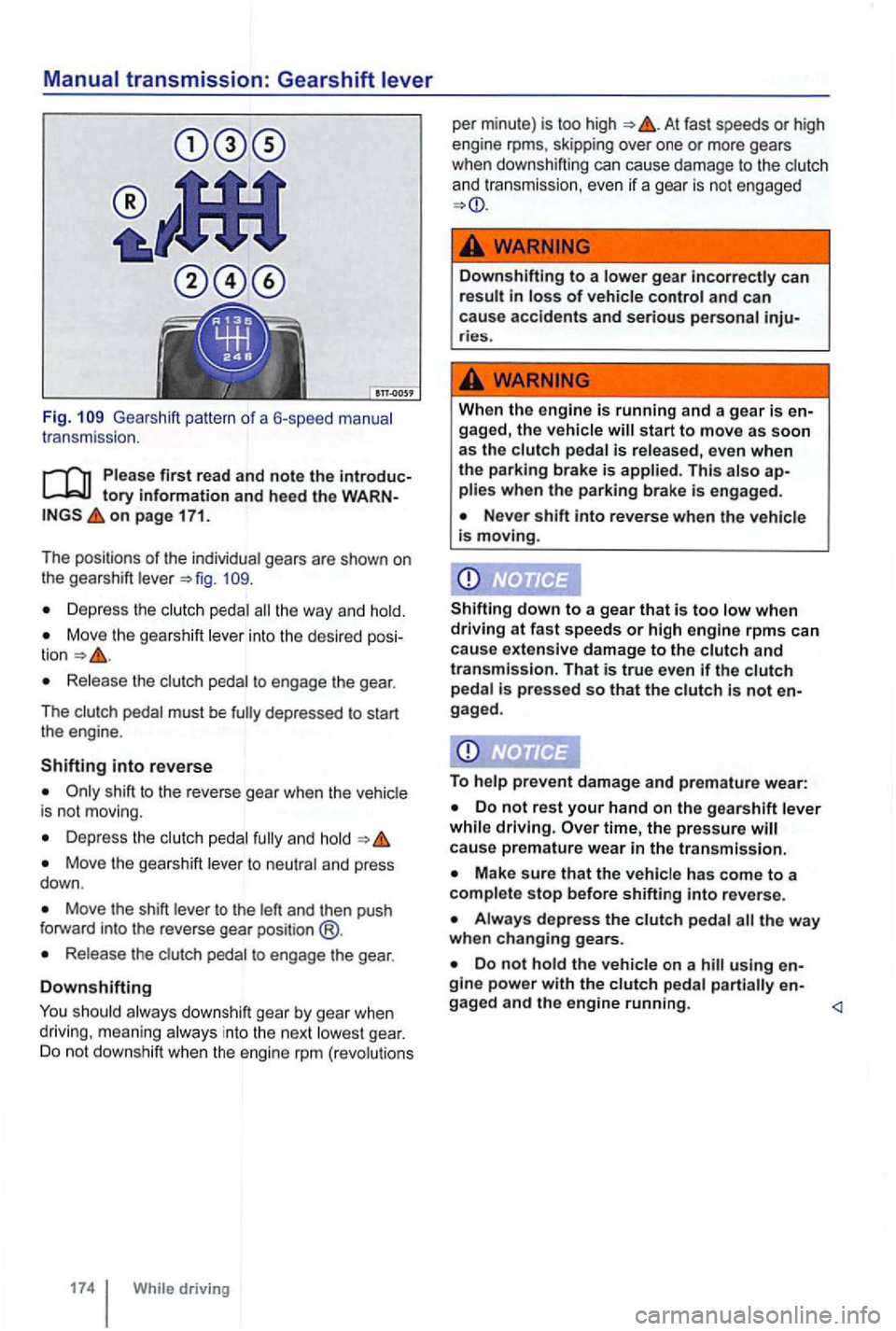
Manual transmission: Gearshift lever
Fig. Gea rshift pattern of a 6-speed manual
t r ansmission .
Please first read and note the introductory information and heed the o n page 171.
The positions of the
individua l gea rs are shown on
t he gearshift leve r
Depress the clutch pedal the way and hold.
Move the gearshift lever into the desired
Release the clutc h pedal to engage the gear.
T he c
lutch pedal must be
shift to the reverse gear when the vehic le
is not moving.
Depr ess the and hold
Move the gearshift lever to neutral and press
down .
Move the shift lever to the left and then push
f orward into the reverse gear position @.
Release the clut ch pedal to engage the gear .
Downshifting
You should always downshift gear by gear when
driving , meaning always in to the next lowes t gear. Do not downshift when the engine rpm (revo lutions
At fast speeds or high
engine rpms, skipping over one or more gears
when downshifting can cause damage to the clutch
and transmission, even
if a gear is not engaged
... -
Down shifting to a lowe r gear incorrectly can result in loss of vehicle control and can
cause accidents and serious personal inju-ries.
When the engine is running and a gear is en-
gaged, the vehic le will start to move as soon
as the c lutch pedal is released, even when
th e parking brake is applied. This a lso ap-plies when the parking brake is engaged.
Never shift into reverse when the vehicle
is moving.
Shifting
down to a gear that is too low when driving at fa st spee ds or high engine rpms can
cause extensive damage to the clutch and
transmission. That is true even if the clutch pedal is pressed so that the clutch is not
To help prevent damage and premature wear:
Do not rest your hand on the gearshift leve r
while driving. time, the pressure ca use premature wear in the transmission.
Make sure that the vehicle has come to a
comple te stop before shifti ng into reve rse.
Do not hold the vehicle on a hill using
Page 275 of 516
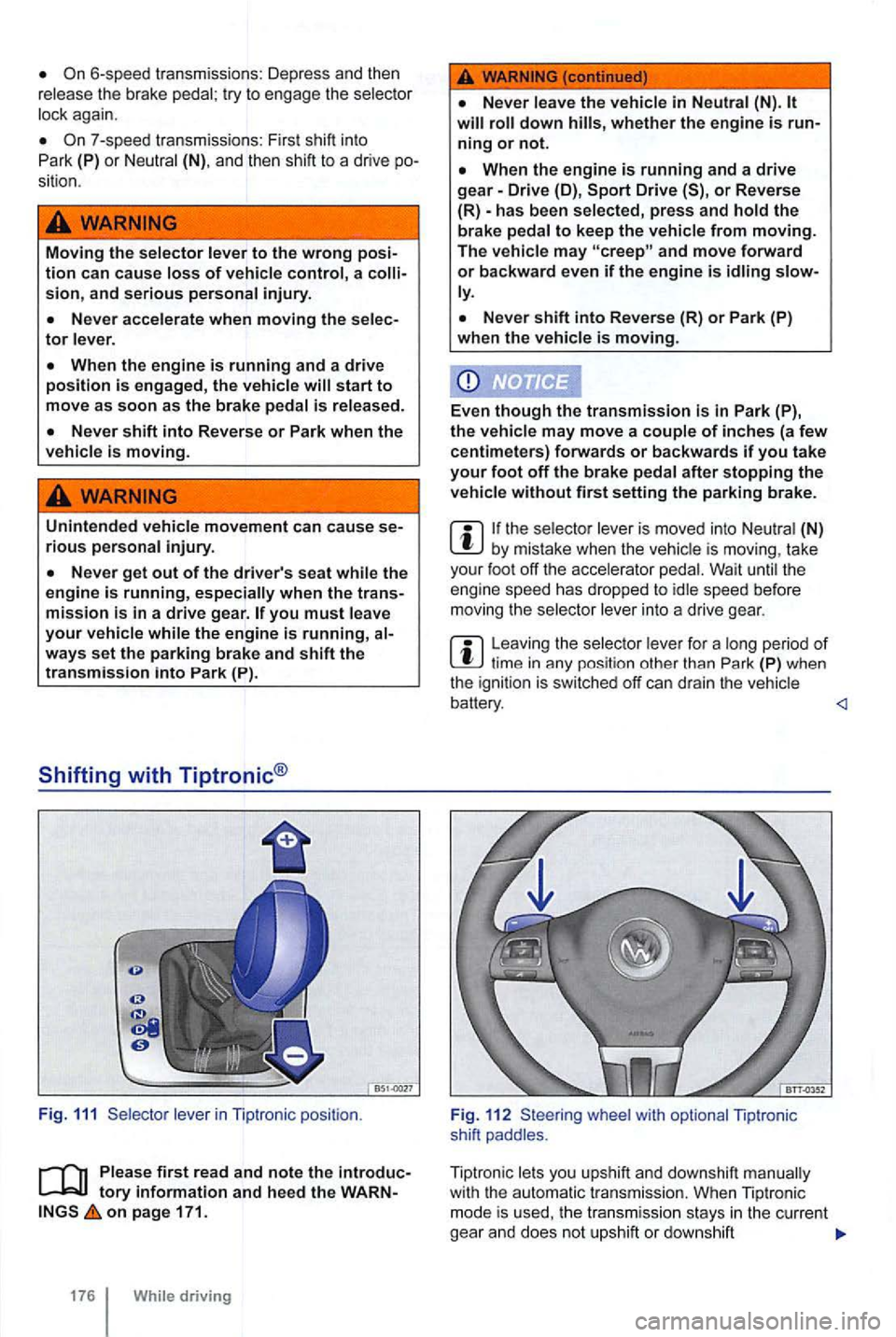
Moving the selector lever to the wrong posi-tion can cause loss of vehicle control, a co sion, and serious personal injury.
Unintended vehicle movement can cause se-rious personal injury.
you must leave your vehicle while the engine is running, al-ways set the parking brake and shift the transmission into Park (P).
Shifting with Tiptronic®
Fig . 111 lever in Tiptronic position.
Please first read and note the introduc
on page 171.
176 While driving
WARNING (continued )
will roll down hills, whether the engine is
When the engine is running and a drive gear-Drive (D), or Reverse
(R) -has been selected, press and hold the
brake pedal to keep the vehicle from moving.
The vehicle may and move forward or backward even if the engine is idling ly.
the selec tor lever is moved into Neutral (N) by mistake when the vehicle is moving , take
your foot off the accelerator pedal. Wait until the
engine speed has dropped to idle speed before
mov ing the selector lever into a drive gear.
Leaving the selector le ver for a long period of
whe el with optional Tiptronic
shift paddles .
Tiptronic lets yo u upshift and downshift manually
with
the a utomatic transm ission. When Tiptronic
mode is used, the transmi ssio n stays in the curren t
gea r and does not upshift or dow nshift
Page 283 of 516
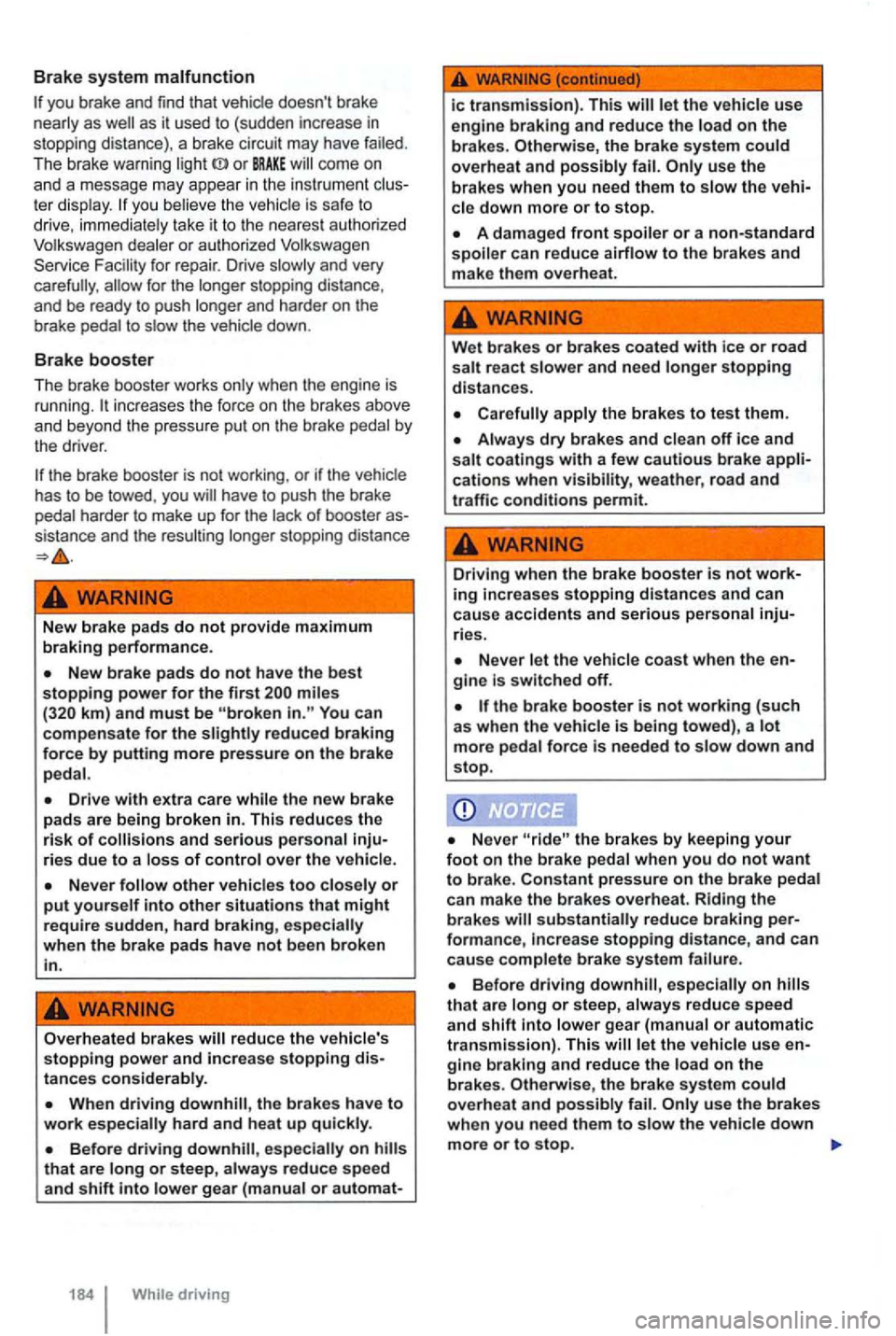
Brake system malfunction
you brake and find that vehicle doesn't brake
nearly as
come on
and a m essage may appear in the instrument ter display. you believe the vehic le is safe to
d rive, immediately take it to the nearest authorized
Volkswagen dealer or authorized Volkswagen
Service
f or repair. Drive slowly and very
carefully , for the longer stopping distance ,
and be ready to push longer and harder on the
brake pedal to slow the vehicle down.
Brake booster
The brake booster works only when the engine is
running . in creases the force on the brakes above
and beyond the pressure put on the brake pedal by
the driver .
New brake pad s do not provide maximum braking performance.
miles You can
compensate for the reduc ed braking force by putting more pressure on the brake
pedal.
other vehicles too closel y or put yourself into other situations that might require sudden, hard braking , especially
when the brake pads have not b ee n broken
in.
Overh eated brakes reduce the vehicle's stopping power and increa se stopping distances considerably.
that are long or s teep, always reduce speed
and shift into lower gear (manual or automat-
184 While driving
ic transmission). This let the vehicle use
engine braking and reduce the load on the brakes. Otherwise, the brake system could overheat and possibly fail.
A damaged front spoiler or a non-standard spoiler can redu ce airflow to th e brakes and make them overheat.
Wet brakes or brakes coated with ice or road
salt react slower and need longer stopping distances.
apply the brakes to tes t them .
Driving when the brake booster is not working increases stopping distances and can
cause accidents and serious per sonal inju
rie s.
Nev er let the vehicle coas t when the
the bra ke booster is not working (suc h
a s wh en th e vehic le is being towed) , a lot more pedal force is needed to slow down and stop.
Neve r the brake s by keeping your foot on the brak e pedal when you do not want to brak e. Constant pres sure on the brake ped al
ca n make the brak es overheat. Riding the bra kes substantially r educe brakin g performance, increase stopping distance, and can
cause complete brake system failure .
that are long or s teep, always reduce speed and shift into lower gear (manua l or automatic tran smission). This gine brakin g and reduce the load on t he brakes. Otherwise, the brake system cou ld
o ve rheat and possibly fail. use the brakes when you n eed them to slow the vehicle down more or to stop.
Page 295 of 516

conditions are
3. A manual transm iss ion vehic le must be in 1st
gear (1 ) i f headed up a or in Reverse (R ) if backing up a you must hold the clut ch down
and the foot brake must be depressed to keep
the vehic
le from moving.
' Rel
ease
the brake as you let the clutch out and gently depress the accelerator.
any requi rement lis ted in the tab le above is
no longer met (see 196 , ed automatically when the following conditions are all met at the same time.).
gine malfunctions .
Automatic transmission vehicles: the mission i s in Neutral (N).
Automatic transmission vehicles:
and
the foot brake must be depressed to keep the
vehic le from moving .
Relea
se the brake as you gently depress the accelerator.
cle in start situations (for example, if the surface icy or slippery).
down the
Page 420 of 516
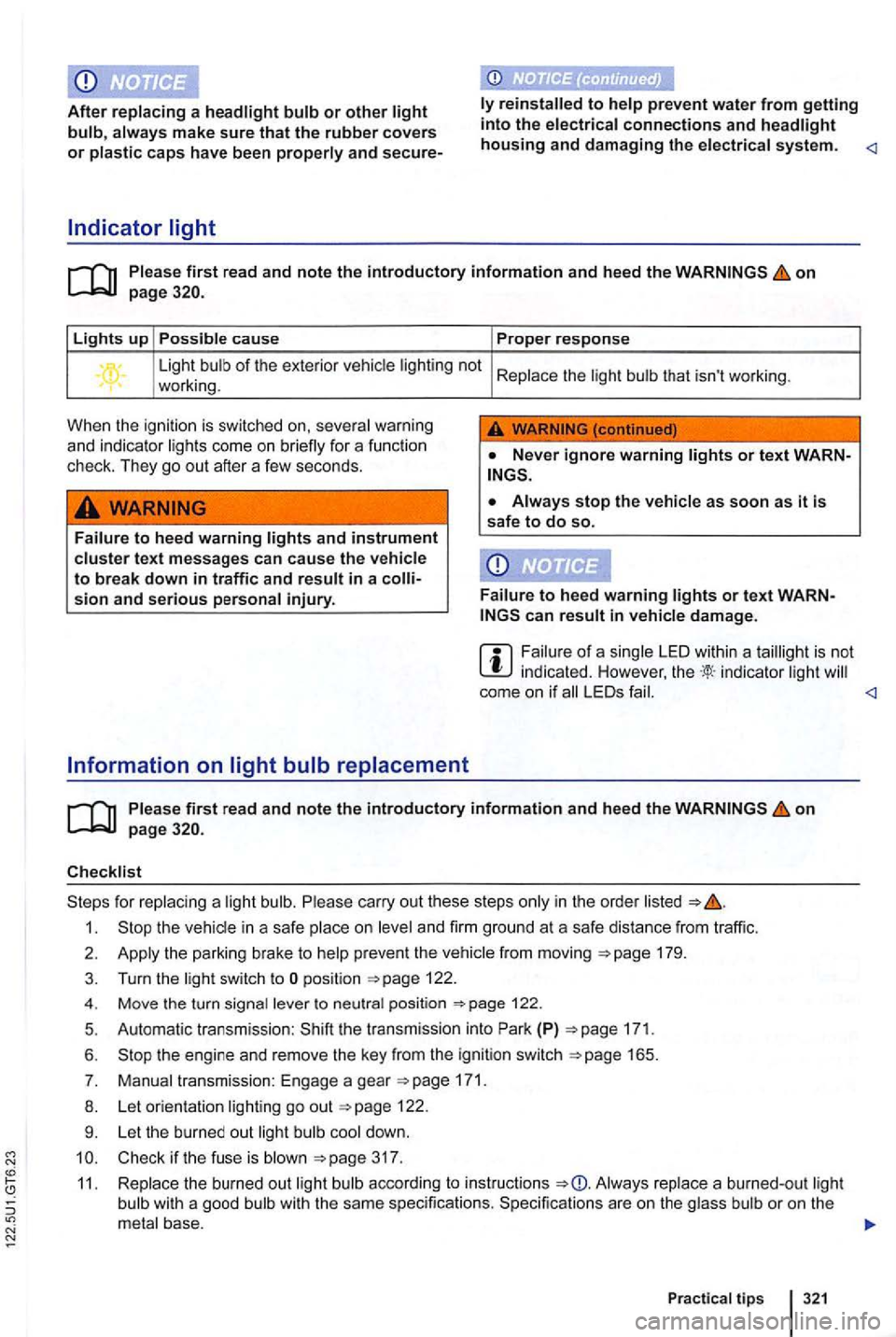
N
After replacing a headlight bulb or other light bulb, always make sure that the rubber covers or plastic caps have been properly and secure-
Indicator light
to help prevent water from getting into the electrical connections and headlight housing and damaging the electrical system.
on
Lights up Possible cause Proper response
Light bulb of the exterior vehicle lighting not Replace the light bulb that isn't working .
working .
When the ignition is switched on, several warning
and indicator lights come on briefly for a function
check . They go
out after a few seconds.
WARNING
Failure to heed warning lights and instrument cluster text messages can cause the vehicle to break down in traffic and result in a
can result in vehicle damage.
indicated. However, indicator light come on if LEO s fail.
on
Checklist
for replacing a light bulb. Please carry out these steps only in the order listed
1.
179.
3.
4.
5.
6 .
7.
8.
9 .
position
122 .
Automatic transmission :
the transmission into Park (P) 171.
the engine and remove the key from the ignition switch 165.
Manual transmission: Engage a gear
122.
Let the burned
out light cool down.
Check
if the fuse is blown 317 .
Replace the burned
out light according to
Practical tips 321